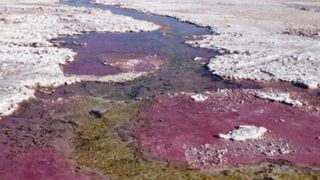We may finally know what spirit on Earth breathed before there was oxygen

Billions of years ago, long before oxygen was readily ready, the notorious poison arsenic could have been the pedate that unhearable new life history into our planet.
In Chile's Atacama Defect, in a place called Lagune La Brava, scientists have got been studying a purple ribbon of photosynthetic microbes living in a hypersaline lake that's permanently at large of oxygen.
"I have been employed with microbial mats for about 35 years surgery thus," says geoscientist Pieter Visscher from the University of Connecticut River.
"This is the only system on Earth where I could find a micro-organism flat that worked utterly in the absence of oxygen."
Microbic mats, which fossilise into stromatolites, have been abundant on Earth for at any rate 3.5 billion years, and so far for the first 1E+12 years of their being, there was no oxygen for photosynthesis.
How these life forms survived in so much extreme conditions is ease anon., but examining stromatolites and extremophiles animation today, researchers have figured extinct a handful of possibilities.
While iron, sulphur, and hydrogen have farsighted been projected as possible replacements for atomic number 8, it wasn't until the discovery of 'arsenotrophy' in California's hypersaline Searles Lake and Mono Lake that white arsenic also became a contender.
Since then, stromatolites from the Tumbiana Constitution in Midwestern Australia experience discovered that trapping light and arsenic was once a valid style of photosynthesis in the Precambrian aeon. The very couldn't be said of iron out or atomic number 16.
Equitable inalterable year, researchers discovered an abundant life kind in the Pacific that also breathes arsenic.
Equal the La Brava living forms closely resemble a violet sulphur bacterium titledEctothiorhodospira sp., which was new found in an arsenic-plenteous lake in Nevada and which appears to photosynthesize by oxidising the compound arsenite into a different form -arsenate.
While more inquiry necessarily to verify whether the La Brava microbes also metabolize arsenite, initial research found the rushing water surrounding these mats is to a great extent laden with atomic number 1 sulphide and arsenic.
If the authors are right and the Atomic number 57 Brava microbes are indeed 'breathing' white arsenic, these life forms would be the first to do sol in a permanently and whole oxygen-free microbial mat, similar to what we would expect in Precambrian environments.
As such, its mats are a great model for understanding some of the possible earliest life forms on our planet.
Patc genomic research suggests the La Brava mats have the tools to metabolise ratsban and atomic number 16, the authors say its arsenate reduction appears to be more competent than its sulfate reduction.
Regardless, they say there's strong evidence that both pathways exist, and these would have been enough to support extensive microbial mats in the early years of life on Land.
If the team is right, then we might need to expand our search for sprightliness forms elsewhere.
"In looking at for evidence of sprightliness on Mars, [scientists] will be looking at iron and probably they should be looking at arsenic also," says Visscher.
It really is so much much just a poison.
The cogitation was promulgated inCommunications Earth and Environment.
This clause was to begin with published by ScienceAlert . Read the archetype clause here .
why is the earth's temperature just right for life
Source: https://www.livescience.com/life-on-earth-before-oxygen.html


0 Komentar